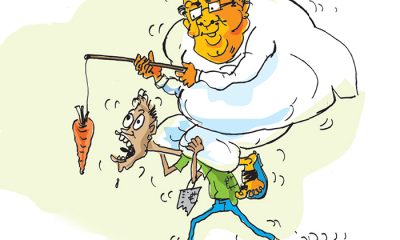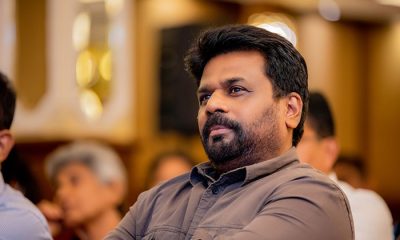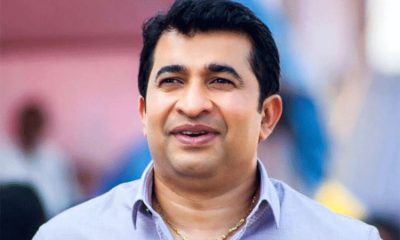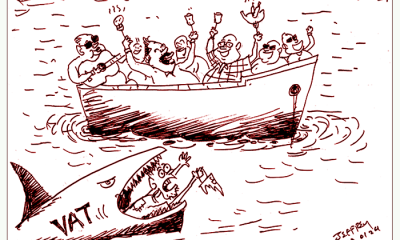Features
Private medical schools: Next assault on Free Education?
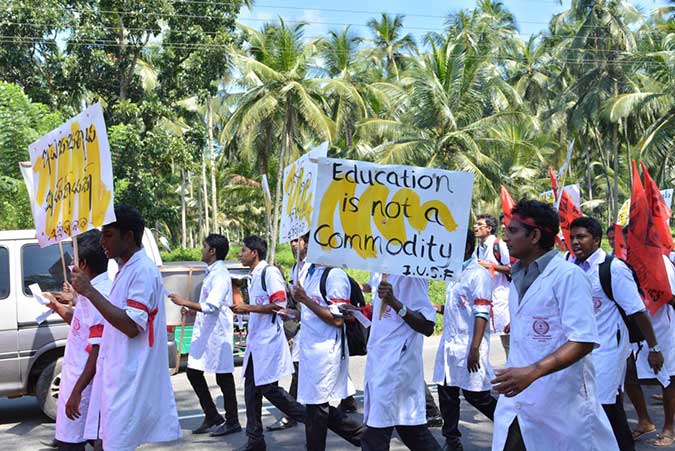
By Ramya Kumar
Interest-free loans of LKR 1.1 million are to be offered for students to follow degree programmes at private higher educational institutions. An amendment to the Universities Act has been proposed to establish a Quality Assurance Council under the University Grants Commission (UGC) to maintain the quality of academic programmes offered by state and non-state higher educational institutions.
According to the government, these policies are designed to increase access to higher education and standardize the quality of academic programmes. However, the relentless attacks on the student movement, arbitrary arrests of Inter-University Students’ Federation (IUSF) leaders and the media campaigns against free education signal a different agenda: privatisation. As the government sets the stage for a ‘radical’ revamping of higher education, this article looks at what might be in store for medical education.
Minimum standards
Private medical education is a sensitive topic in Sri Lanka, so much so that the government has kept mum about its plans. The foundation for the establishment of private medical schools has already been laid through the setting up of an Accreditation Unit under the Sri Lanka Medical Council (SLMC). The medical fraternity may oppose private medical schools of questionable standards, but does not, in principle, object to private medical education. Indeed, there is much complacency on this front since the gazetting of the Minimum Standards of Medical Education in 2018, after the SAITM debacle. Even the Government Medical Officers’ Association (GMOA), which opposed SAITM based on ‘quality’ concerns, now simply demands that they be consulted in matters pertaining to private medical education.
It is believed that the quality of MBBS degree programmes can be assured by the requirements set out in the Minimum Standards, for instance, minimum qualifications for student admission, staff requirements, hospital bed numbers, bed occupancy rates, etc. To be sure, the Minimum Standards do set much-needed ‘benchmarks’ to check the proliferation of low-quality private medical schools.
However, by considering state and non-state medical schools on an equal footing, neither the Minimum Standards nor accreditation processes give due consideration to the impact private medical schools will have on state medical faculties. In particular, they overlook equity and justice in access to medical education.
An unhealthy symbiosis
Take, for instance, the staff requirements laid out in the Minimum Standards. In terms of academic staff, the Standards specify that MBBS degree-awarding institutions should “conform to teacher-student ratios… not less than one teacher for every 14 medical students, taking into account the permanent academic staff and the extended faculty of specialists in affiliated teaching hospitals and other healthcare settings.” They include provisions for a balance between full-time and part-time academic staff, and ask that “all medically qualified staff engaged in patient care are registered with the designated body responsible for registration of medical professions in the relevant country” (Note: the Minimum Standards apply to overseas medical schools that produce MBBS graduates who intend to work in Sri Lanka).
In the event that private medical schools set foot in the country, it is unlikely that these institutions will be able to attract diaspora medical professionals who could renew their SLMC registration, given the economic situation in the country. Therefore, these institutions would need to rely on retired medical professionals or current teaching faculty at state medical faculties. As the Standards do not place limits on teaching hours, university teachers will be able to divide their time between public and private medical schools (akin to ‘dual practice’ by clinicians) or, if the benefits are appealing, a wholesale movement from state to private medical schools may occur.
If teaching faculty engage in ‘dual practice’ in state and private medical schools, there is no guarantee that their primary commitments will remain with state medical faculties. Given the required hospital beds and occupancy rates specified in the Minimum Standards, private medical schools may need to rely on public hospitals for clinical training. For this reason, they may be located adjacent to tertiary hospitals in peripheral districts that do not serve as clinical training centres for students of state medical faculties.
Winners and losers
Student intake to state universities, including medical faculties, has steeply risen in recent years (see table). Even so, the Colombo Medical Faculty has been able to maintain its student to permanent academic staff ratio at 7:1. Owing to its location, the Colombo Medical Faculty would be able to attract medical professionals to full-time teaching positions despite the higher salaries offered by the Ministry of Health.
However, the student to permanent academic staff ratio at the Jaffna Medical Faculty has risen over the years, climbing to 19:1 in 2021. The availability of vacant cadre positions at Ministry of Health institutions in and around Jaffna gives medical professionals no reason to resign from the Ministry to take up teaching positions that pay substantially less. (See table)
The requirement of 14:1 is fulfilled by state medical faculties in peripheral districts when temporary staff and extended faculty at teaching hospitals are considered. Yet, curriculum development, ‘quality assurance,’ student welfare and other time-consuming activities are undertaken primarily by permanent academic staff. If private medical schools are established in such districts, state medical faculties will need to compete not only with the Ministry of Health, but also with private medical schools that can offer much higher salaries, causing a dearth in teaching staff at state medical faculties.
Equity of access
The government will gloss over equity concerns by promising loans, voucher schemes and other carrots to study at private medical schools. Even as the state university system as a whole is seeing declines in state investment (see table), and even more so after the economic crisis, it is unclear how these loans will be financed. Accumulating student debt has shown to influence the career choices of medical students in other settings.
As the country struggles to retain medical professionals, it is unlikely that medical graduates burdened by student debt will serve in the public health sector under the present salary structure. It is even less likely that fee-levying international students, the government’s primary target for forex, will serve in Sri Lanka’s health sector. In other words, whether private medical schools will produce medical professionals to service the healthcare needs of ordinary citizens is uncertain.
The entry of private medical schools will change the demographic makeup of medical students by creating a two-tiered system of medical education. Given the emphasis on student resumes and ‘soft skills’, not to mention the hefty fees that will be levied, those who enter private medical schools will mostly represent the middle/upper-middle classes. According to UGC statistics, in 2020/2021, about 63% of enrollment in state medical faculties was through the district quote system. While the Colombo elite suggest that this is a form of reverse discrimination, such arguments overlook the tremendous disadvantages experienced by students from rural districts.
A closer look at the UGC’s admission statistics of 2020/2021 shows that the majority of students who entered medicine from the Vanni districts, Polonnaruwa, Anuradhapura, Moneragala and Nuwara Eliya, did so through the district quotas. With the entrenchment of private medical education, and weakening of state medical faculties, the opportunities for students from rural and plantation districts to access medical education will contract. It must be remembered that it is also these students who tend to populate peripherally located state medical faculties.
Ideology in the making
As health professionals leave en masse from the country, it is argued that private medical schools might present a solution for physician brain drain. The entry of private medical schools will surely create a two-tiered system with lasting impacts on who has access to medical education and on the healthcare system more broadly. Until now, state medical faculties have furnished the public health sector with its medical cadre. While there is certainly room for improvement, at this point, the focus should be on supporting state medical faculties to ensure the survival of the public health sector.
As welfare is steadily chipped away in the name of the economic crisis, the government, supported by sections of the elite, suggest that it is a ‘welfare mindset’ that has brought the country to this state of crisis. The media is drumming up support for the government’s short-sighted policies, including the dismantling of free education. Images of student protests are being deployed to further delegitimize state universities, detracting attention from the ongoing mass-scale dispossession that is taking place in this country, whether through ‘domestic debt optimisation’, labour reforms or the proposals on restructuring higher education and public health. In this context, opposing private medical education is portrayed as ‘ideological’ or impractical, concealing the ideological work that has been undertaken over the years to convince many to believe that fee-levying university education is the way forward.
(The author is attached to the Department of Community and Family Medicine, Faculty of Medicine, University of Jaffna)
Kuppi is a politics and pedagogy happening on the margins of the lecture hall that parodies, subverts, and simultaneously reaffirms social hierarchies.
Features
The heart-friendly health minister

by Dr Gotabhya Ranasinghe
Senior Consultant Cardiologist
National Hospital Sri Lanka
When we sought a meeting with Hon Dr. Ramesh Pathirana, Minister of Health, he graciously cleared his busy schedule to accommodate us. Renowned for his attentive listening and deep understanding, Minister Pathirana is dedicated to advancing the health sector. His openness and transparency exemplify the qualities of an exemplary politician and minister.
Dr. Palitha Mahipala, the current Health Secretary, demonstrates both commendable enthusiasm and unwavering support. This combination of attributes makes him a highly compatible colleague for the esteemed Minister of Health.
Our discussion centered on a project that has been in the works for the past 30 years, one that no other minister had managed to advance.
Minister Pathirana, however, recognized the project’s significance and its potential to revolutionize care for heart patients.
The project involves the construction of a state-of-the-art facility at the premises of the National Hospital Colombo. The project’s location within the premises of the National Hospital underscores its importance and relevance to the healthcare infrastructure of the nation.
This facility will include a cardiology building and a tertiary care center, equipped with the latest technology to handle and treat all types of heart-related conditions and surgeries.
Securing funding was a major milestone for this initiative. Minister Pathirana successfully obtained approval for a $40 billion loan from the Asian Development Bank. With the funding in place, the foundation stone is scheduled to be laid in September this year, and construction will begin in January 2025.
This project guarantees a consistent and uninterrupted supply of stents and related medications for heart patients. As a result, patients will have timely access to essential medical supplies during their treatment and recovery. By securing these critical resources, the project aims to enhance patient outcomes, minimize treatment delays, and maintain the highest standards of cardiac care.
Upon its fruition, this monumental building will serve as a beacon of hope and healing, symbolizing the unwavering dedication to improving patient outcomes and fostering a healthier society.We anticipate a future marked by significant progress and positive outcomes in Sri Lanka’s cardiovascular treatment landscape within the foreseeable timeframe.
Features
A LOVING TRIBUTE TO JESUIT FR. ALOYSIUS PIERIS ON HIS 90th BIRTHDAY

by Fr. Emmanuel Fernando, OMI
Jesuit Fr. Aloysius Pieris (affectionately called Fr. Aloy) celebrated his 90th birthday on April 9, 2024 and I, as the editor of our Oblate Journal, THE MISSIONARY OBLATE had gone to press by that time. Immediately I decided to publish an article, appreciating the untiring selfless services he continues to offer for inter-Faith dialogue, the renewal of the Catholic Church, his concern for the poor and the suffering Sri Lankan masses and to me, the present writer.
It was in 1988, when I was appointed Director of the Oblate Scholastics at Ampitiya by the then Oblate Provincial Fr. Anselm Silva, that I came to know Fr. Aloy more closely. Knowing well his expertise in matters spiritual, theological, Indological and pastoral, and with the collaborative spirit of my companion-formators, our Oblate Scholastics were sent to Tulana, the Research and Encounter Centre, Kelaniya, of which he is the Founder-Director, for ‘exposure-programmes’ on matters spiritual, biblical, theological and pastoral. Some of these dimensions according to my view and that of my companion-formators, were not available at the National Seminary, Ampitiya.
Ever since that time, our Oblate formators/ accompaniers at the Oblate Scholasticate, Ampitiya , have continued to send our Oblate Scholastics to Tulana Centre for deepening their insights and convictions regarding matters needed to serve the people in today’s context. Fr. Aloy also had tried very enthusiastically with the Oblate team headed by Frs. Oswald Firth and Clement Waidyasekara to begin a Theologate, directed by the Religious Congregations in Sri Lanka, for the contextual formation/ accompaniment of their members. It should very well be a desired goal of the Leaders / Provincials of the Religious Congregations.
Besides being a formator/accompanier at the Oblate Scholasticate, I was entrusted also with the task of editing and publishing our Oblate journal, ‘The Missionary Oblate’. To maintain the quality of the journal I continue to depend on Fr. Aloy for his thought-provoking and stimulating articles on Biblical Spirituality, Biblical Theology and Ecclesiology. I am very grateful to him for his generous assistance. Of late, his writings on renewal of the Church, initiated by Pope St. John XX111 and continued by Pope Francis through the Synodal path, published in our Oblate journal, enable our readers to focus their attention also on the needed renewal in the Catholic Church in Sri Lanka. Fr. Aloy appreciated very much the Synodal path adopted by the Jesuit Pope Francis for the renewal of the Church, rooted very much on prayerful discernment. In my Religious and presbyteral life, Fr.Aloy continues to be my spiritual animator / guide and ongoing formator / acccompanier.
Fr. Aloysius Pieris, BA Hons (Lond), LPh (SHC, India), STL (PFT, Naples), PhD (SLU/VC), ThD (Tilburg), D.Ltt (KU), has been one of the eminent Asian theologians well recognized internationally and one who has lectured and held visiting chairs in many universities both in the West and in the East. Many members of Religious Congregations from Asian countries have benefited from his lectures and guidance in the East Asian Pastoral Institute (EAPI) in Manila, Philippines. He had been a Theologian consulted by the Federation of Asian Bishops’ Conferences for many years. During his professorship at the Gregorian University in Rome, he was called to be a member of a special group of advisers on other religions consulted by Pope Paul VI.
Fr. Aloy is the author of more than 30 books and well over 500 Research Papers. Some of his books and articles have been translated and published in several countries. Among those books, one can find the following: 1) The Genesis of an Asian Theology of Liberation (An Autobiographical Excursus on the Art of Theologising in Asia, 2) An Asian Theology of Liberation, 3) Providential Timeliness of Vatican 11 (a long-overdue halt to a scandalous millennium, 4) Give Vatican 11 a chance, 5) Leadership in the Church, 6) Relishing our faith in working for justice (Themes for study and discussion), 7) A Message meant mainly, not exclusively for Jesuits (Background information necessary for helping Francis renew the Church), 8) Lent in Lanka (Reflections and Resolutions, 9) Love meets wisdom (A Christian Experience of Buddhism, 10) Fire and Water 11) God’s Reign for God’s poor, 12) Our Unhiddden Agenda (How we Jesuits work, pray and form our men). He is also the Editor of two journals, Vagdevi, Journal of Religious Reflection and Dialogue, New Series.
Fr. Aloy has a BA in Pali and Sanskrit from the University of London and a Ph.D in Buddhist Philosophy from the University of Sri Lankan, Vidyodaya Campus. On Nov. 23, 2019, he was awarded the prestigious honorary Doctorate of Literature (D.Litt) by the Chancellor of the University of Kelaniya, the Most Venerable Welamitiyawe Dharmakirthi Sri Kusala Dhamma Thera.
Fr. Aloy continues to be a promoter of Gospel values and virtues. Justice as a constitutive dimension of love and social concern for the downtrodden masses are very much noted in his life and work. He had very much appreciated the commitment of the late Fr. Joseph (Joe) Fernando, the National Director of the Social and Economic Centre (SEDEC) for the poor.
In Sri Lanka, a few religious Congregations – the Good Shepherd Sisters, the Christian Brothers, the Marist Brothers and the Oblates – have invited him to animate their members especially during their Provincial Congresses, Chapters and International Conferences. The mainline Christian Churches also have sought his advice and followed his seminars. I, for one, regret very much, that the Sri Lankan authorities of the Catholic Church –today’s Hierarchy—- have not sought Fr.
Aloy’s expertise for the renewal of the Catholic Church in Sri Lanka and thus have not benefited from the immense store of wisdom and insight that he can offer to our local Church while the Sri Lankan bishops who governed the Catholic church in the immediate aftermath of the Second Vatican Council (Edmund Fernando OMI, Anthony de Saram, Leo Nanayakkara OSB, Frank Marcus Fernando, Paul Perera,) visited him and consulted him on many matters. Among the Tamil Bishops, Bishop Rayappu Joseph was keeping close contact with him and Bishop J. Deogupillai hosted him and his team visiting him after the horrible Black July massacre of Tamils.
Features
A fairy tale, success or debacle

Sri Lanka-Singapore Free Trade Agreement
By Gomi Senadhira
senadhiragomi@gmail.com
“You might tell fairy tales, but the progress of a country cannot be achieved through such narratives. A country cannot be developed by making false promises. The country moved backward because of the electoral promises made by political parties throughout time. We have witnessed that the ultimate result of this is the country becoming bankrupt. Unfortunately, many segments of the population have not come to realize this yet.” – President Ranil Wickremesinghe, 2024 Budget speech
Any Sri Lankan would agree with the above words of President Wickremesinghe on the false promises our politicians and officials make and the fairy tales they narrate which bankrupted this country. So, to understand this, let’s look at one such fairy tale with lots of false promises; Ranil Wickremesinghe’s greatest achievement in the area of international trade and investment promotion during the Yahapalana period, Sri Lanka-Singapore Free Trade Agreement (SLSFTA).
It is appropriate and timely to do it now as Finance Minister Wickremesinghe has just presented to parliament a bill on the National Policy on Economic Transformation which includes the establishment of an Office for International Trade and the Sri Lanka Institute of Economics and International Trade.
Was SLSFTA a “Cleverly negotiated Free Trade Agreement” as stated by the (former) Minister of Development Strategies and International Trade Malik Samarawickrama during the Parliamentary Debate on the SLSFTA in July 2018, or a colossal blunder covered up with lies, false promises, and fairy tales? After SLSFTA was signed there were a number of fairy tales published on this agreement by the Ministry of Development Strategies and International, Institute of Policy Studies, and others.
However, for this article, I would like to limit my comments to the speech by Minister Samarawickrama during the Parliamentary Debate, and the two most important areas in the agreement which were covered up with lies, fairy tales, and false promises, namely: revenue loss for Sri Lanka and Investment from Singapore. On the other important area, “Waste products dumping” I do not want to comment here as I have written extensively on the issue.
1. The revenue loss
During the Parliamentary Debate in July 2018, Minister Samarawickrama stated “…. let me reiterate that this FTA with Singapore has been very cleverly negotiated by us…. The liberalisation programme under this FTA has been carefully designed to have the least impact on domestic industry and revenue collection. We have included all revenue sensitive items in the negative list of items which will not be subject to removal of tariff. Therefore, 97.8% revenue from Customs duty is protected. Our tariff liberalisation will take place over a period of 12-15 years! In fact, the revenue earned through tariffs on goods imported from Singapore last year was Rs. 35 billion.
The revenue loss for over the next 15 years due to the FTA is only Rs. 733 million– which when annualised, on average, is just Rs. 51 million. That is just 0.14% per year! So anyone who claims the Singapore FTA causes revenue loss to the Government cannot do basic arithmetic! Mr. Speaker, in conclusion, I call on my fellow members of this House – don’t mislead the public with baseless criticism that is not grounded in facts. Don’t look at petty politics and use these issues for your own political survival.”
I was surprised to read the minister’s speech because an article published in January 2018 in “The Straits Times“, based on information released by the Singaporean Negotiators stated, “…. With the FTA, tariff savings for Singapore exports are estimated to hit $10 million annually“.
As the annual tariff savings (that is the revenue loss for Sri Lanka) calculated by the Singaporean Negotiators, Singaporean $ 10 million (Sri Lankan rupees 1,200 million in 2018) was way above the rupees’ 733 million revenue loss for 15 years estimated by the Sri Lankan negotiators, it was clear to any observer that one of the parties to the agreement had not done the basic arithmetic!
Six years later, according to a report published by “The Morning” newspaper, speaking at the Committee on Public Finance (COPF) on 7th May 2024, Mr Samarawickrama’s chief trade negotiator K.J. Weerasinghehad had admitted “…. that forecasted revenue loss for the Government of Sri Lanka through the Singapore FTA is Rs. 450 million in 2023 and Rs. 1.3 billion in 2024.”
If these numbers are correct, as tariff liberalisation under the SLSFTA has just started, we will pass Rs 2 billion very soon. Then, the question is how Sri Lanka’s trade negotiators made such a colossal blunder. Didn’t they do their basic arithmetic? If they didn’t know how to do basic arithmetic they should have at least done their basic readings. For example, the headline of the article published in The Straits Times in January 2018 was “Singapore, Sri Lanka sign FTA, annual savings of $10m expected”.
Anyway, as Sri Lanka’s chief negotiator reiterated at the COPF meeting that “…. since 99% of the tariffs in Singapore have zero rates of duty, Sri Lanka has agreed on 80% tariff liberalisation over a period of 15 years while expecting Singapore investments to address the imbalance in trade,” let’s turn towards investment.
Investment from Singapore
In July 2018, speaking during the Parliamentary Debate on the FTA this is what Minister Malik Samarawickrama stated on investment from Singapore, “Already, thanks to this FTA, in just the past two-and-a-half months since the agreement came into effect we have received a proposal from Singapore for investment amounting to $ 14.8 billion in an oil refinery for export of petroleum products. In addition, we have proposals for a steel manufacturing plant for exports ($ 1 billion investment), flour milling plant ($ 50 million), sugar refinery ($ 200 million). This adds up to more than $ 16.05 billion in the pipeline on these projects alone.
And all of these projects will create thousands of more jobs for our people. In principle approval has already been granted by the BOI and the investors are awaiting the release of land the environmental approvals to commence the project.
I request the Opposition and those with vested interests to change their narrow-minded thinking and join us to develop our country. We must always look at what is best for the whole community, not just the few who may oppose. We owe it to our people to courageously take decisions that will change their lives for the better.”
According to the media report I quoted earlier, speaking at the Committee on Public Finance (COPF) Chief Negotiator Weerasinghe has admitted that Sri Lanka was not happy with overall Singapore investments that have come in the past few years in return for the trade liberalisation under the Singapore-Sri Lanka Free Trade Agreement. He has added that between 2021 and 2023 the total investment from Singapore had been around $162 million!
What happened to those projects worth $16 billion negotiated, thanks to the SLSFTA, in just the two-and-a-half months after the agreement came into effect and approved by the BOI? I do not know about the steel manufacturing plant for exports ($ 1 billion investment), flour milling plant ($ 50 million) and sugar refinery ($ 200 million).
However, story of the multibillion-dollar investment in the Petroleum Refinery unfolded in a manner that would qualify it as the best fairy tale with false promises presented by our politicians and the officials, prior to 2019 elections.
Though many Sri Lankans got to know, through the media which repeatedly highlighted a plethora of issues surrounding the project and the questionable credentials of the Singaporean investor, the construction work on the Mirrijiwela Oil Refinery along with the cement factory began on the24th of March 2019 with a bang and Minister Ranil Wickremesinghe and his ministers along with the foreign and local dignitaries laid the foundation stones.
That was few months before the 2019 Presidential elections. Inaugurating the construction work Prime Minister Ranil Wickremesinghe said the projects will create thousands of job opportunities in the area and surrounding districts.
The oil refinery, which was to be built over 200 acres of land, with the capacity to refine 200,000 barrels of crude oil per day, was to generate US$7 billion of exports and create 1,500 direct and 3,000 indirect jobs. The construction of the refinery was to be completed in 44 months. Four years later, in August 2023 the Cabinet of Ministers approved the proposal presented by President Ranil Wickremesinghe to cancel the agreement with the investors of the refinery as the project has not been implemented! Can they explain to the country how much money was wasted to produce that fairy tale?
It is obvious that the President, ministers, and officials had made huge blunders and had deliberately misled the public and the parliament on the revenue loss and potential investment from SLSFTA with fairy tales and false promises.
As the president himself said, a country cannot be developed by making false promises or with fairy tales and these false promises and fairy tales had bankrupted the country. “Unfortunately, many segments of the population have not come to realize this yet”.
(The writer, a specialist and an activist on trade and development issues . )




